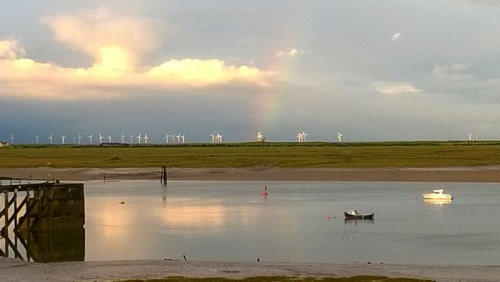
The first Barrow Harbour Act was obtained in 1848 which allowed the port to borrow funds from the infant Furness Railway Company
[and allow the FR to lend], £5000. The railway company of course, was keen to expand its mineral traffic, (Iron Ore), through the small port
of Barrow. Even until November 1872 Barrow was legally only ‘a creek’ under the Port of Lancaster, it had a considerable amount of trade.
In 1848 1,413 vessels entered the port exporting 120,000 tons of cargo.
In 1849 1,911 vessels entered the port exporting 160,000 tons of cargo.
99% of the cargo was minerals of which 100% was fine grade haematite
ore which mostly went to, South Wales.
In 1857 the Port Commissioners borrowed another £30,000 from the
Furness Railway; aka, the Dukes of Devonshire & Buccleuch, to carry out
dredging in Barrow Channel, [between Barrow town & Barrow Island], which
enabled ships of 500 tons to sail even on a neap tide.
In 1861 the Furness Railway Engineers recommended a plan for the
“Barrow Float & Tidal Basin scheme” to FR directors …er, the Dukes of
Devonshire & Buccleuch. This enabled the whole harbour be turned over to the
Furness Railway Company and enabled them to raise capital of £137,000.
£120,000 for the construction of Devonshire & Buccleuch docks and £17,000 to
repay loans from, guess who? The Harbour Commissioners….. The Dukes of
Devonshire & Buccleuch!
Devonshire Dock was completed in 1867 by Messrs. Brassey & Field, the sandstone being brought from Hawcoat quarry via a railway
line laid for the purpose. Devonshire Dock was opened to a great fanfare on the 19th September 1867, the SS Herald sailed in with among
others onboard the Prime Minister, the Rt Hon WE Gladstone. That day he gave a rousing speech declaring that,
By 1859 Schneider and Hanney had blown in the first two blast furnaces at Hindpool. At
the same time the ore flowed into Barrow from Stank, Lindal, Askam and elsewhere in
Furness in ever increasing quantities, so much so that the roads ran red when it rained. The
small piers in Barrow Channel couldn’t cope, so new but equally inadequate piers were built.
The queues of ships waiting to be loaded became longer, each captain having his favourite
anchorage. A small bay on the Old Barrow side of the channel became known as Welshman’s
Bay, because it found favour with so many of the Welsh skippers; but, money was not to be
made by having ships lying idle at anchor, something had to be done - and it was!
The Barrow Harbour Bill, given Royal Assent in June 1863, was the beginning of a
building project so huge is to span the next eighteen years. Devonshire Dock was opened by
Prime Minister Gladstone in September 1867, the 60ft entrance to the new dock being
adjacent to the present day Maritime Museum, “The Dock.” (The old Graving Dock).
During dredging operations for Devonshire Dock Bewley Wife Steps disappeared for
ever. This ancient route to Old Barrow and Walney was replaced by an embankment following
the line Michaelson Road takes today. When Buccleuch Dock was completed in 1873 a low
level swing bridge was installed into the embankment to allow ships passage between the
two docks, a further embankment being built at Salthouse to enclose the two docks. Walking
from town to Barrow Island the road dipped downhill to the bridge then uphill from the bridge onto Barrow Island instead of today’s level
journey via the High Level Bridge.
James Ramsden a man of great perception, pictured a dock system actually won from the sea itself. Not for him the mere dredging and
bricking in of an existing channel; although a huge undertaking, technically a simple job.
Ramsden’s Dock
As Ramsden’s plan took shape an embankment was built across Roose Sands from Parrock Hall,
[near Roosecote Power Station], to join with the previously built south wall of Ramsden Dock Basin which
reached out and encompassed Ramsey Island.
Ramsey Island, once an island in its own right in Walney Channel it is now the site of the new
Ramsden Dock entrance completed in 1998.
After months of toil the embankment that would enclose a vast stretch of water, later named after
the Cavendish family, was finished except for 300 feet at the westerly end, which was left to be completed
on the neap tide of August 1878. This gap, deliberately left in the dock wall gave the tide free passage,
keeping the water levels equal as it ebbed and flowed. This prevented pressure building up and stopped
the tide from scouring the earth foundations. With a gargantuan effort on the neap tide of August, over
300 navvies moved more than 4000 cubic yards of earthwork, successfully denying the sea entry at high
tide. At the other end of the basin behind an earth coffer-dam, the workmen laboured using primitive
equipment to install the huge gates made by the Barrow Iron Ship Company.
During the construction of Ramsden Dock the Furness Railway were spending £10,000 a month on
the project - this would equate to almost £1,000,000 today.
In 1878, installation complete; the dock basin was flooded. The pumps of the day did not have the necessary capacity or reliability for
continuous duty on a scale necessary to fill an entire dock basin, (they would have still been pumping today). So this no mean feat was
achieved by using a twenty inch diameter syphon. Working for five hours either side of high tide, the syphon passed several thousand gallons
of water taken from Walney Channel per hour. Filling the dock by this long-winded method they pressurised the inside of the gates thus
preventing the ingress of mud and earth when the cofferdam was removed, so dredging in Walney Channel could begin.
Ramsden’s dock, although a greater technical achievement, was opened with little of the pomp lavished on Devonshire Dock. At
10.30am on March 24th 1879 a crowd of three hundred cheered and a two gun salute was fired as the steamship ‘Ariadne’ owned by James
Little and Co., sailed into the basin. The entrance to the dock system from Walney Channel adequate though it was in Ramsden’s day, within
twenty years was proving to be a bottleneck.
Even if Ramsden’s vivid imagination foresaw the trend away
from many small ships carrying small tonnages; to the economics of
much larger ships carrying tonnages previously unheard of, he did
not appreciate the scale or the speed with which this would happen.
1901, five years after Ramdsen’s death, the dock entrance cill
was lowered to accommodate the draughts of ever larger ships under
construction in Vickers, [who bore the cost of the improvements.] To
a degree, the work alleviated the problem. But only a decade later
the entrance width at 97’ 3” was giving cause for concern at Vickers
and the Admiralty, who envisaged a need for ships with beams
exceeding 100’. The outcome of this concern was a plan devised by
Tritton and Palmer, Consulting Engineers to the Furness Railway.
A completely new entrance was to be made in the area now
occupied by the INS Nuclear Terminal. An entry basin would extend
down to the deep water channel entering it at a point north of Sheep
Island. The gates were planned to be 150’ wide and the water on the
cill 7’ 6” deeper than the old entrance. A considerable advantage to
all concerned, Estimated cost at 1916 prices £550,500.
At that time the plan came to came to nought, but reared its
head again in 1922. This time a deputation including the Mayor and
captains of local industry approached the London and North Western
and Midland Railways with a modified plan, which this time included
reclaiming a large part of Roosecote Sands. There they intended
building a tank farm for oil and petrol storage. The board and
directors of the railway company expressed their pleasure in
receiving the deputation and hearing their views. The deputation, for
their part, thanked the directors for their time and co-operation; the
meeting terminated - and so did the grand plan!
Bearing in mind the restriction imposed on their business, in
view of ship owners demanding ever larger ships to transport oil and
iron ore in bulk; and the importance at that time of those particular
cargoes to Barrow; Vickers again reviewed the prospect of a new
dock entrance in 1925. The estimated cost was now £1,000,000.
A table produced then, showed how ships constructed in the
forty six years since the docks completion, had outgrown the port’s
capability to accept them. On a total of 545 occasions during 1925, a
variety of ships with draughts between twenty and twenty five feet
were unable to enter due to insufficient water at the entrance (the
cill). Again nothing was done; the plan shelved once more.
In more recent times the British Admiral, Europe’s first 100,000
ton oil tanker had to be fitted out moored at the deep water berth in
Walney Channel because she was too broad in the beam to enter the
docks and make her way round to the fitting out berths. To carry out
the work, a village of workshops and huts sprung up on the beach
alongside the giant ship. These were reminiscent: and not far from,
the original site of the abomination that graced Old Barrow’s shores eighty years before: ‘The Huts.’
Eighty two years after the inadequacy of the dock entrance was first recognised, work on a new 120’ wide entrance was completed in
1998. The project although not quite as adventurous in scope as the 1916 plan, was a massive feat of civil engineering. The contract awarded
in July 1989 to an Anglo-Dutch consortium required the old entrance
to remain in service while the new one was being built. To enable this
to be done, the new concrete structure was built inside a novel
pneumatic cofferdam twenty four metres high. The 58,000 ton
structure floating on a bed of compressed air, was then sunk into
position by men working underneath in conditions similar to that
experienced by deep sea divers. Decompression the only relaxation
they could look forward to, they blasted away the sand and mud
using high powered water hoses. Slowly over a period of months the
concrete structure disappeared from sight to become a homogeneous
part of its surroundings. The dock gates; one of the last pieces to be
installed, were manufactured by Sir William Arrol Co of Glasgow and
are of the latest ‘drop leaf’ design weighing 380 tonnes.
Long overdue, the new dock entrance was constructed primarily
for the use of a new class of ‘Trident’ submarine, then building at
V.S.E.L. Although I say long overdue, the decline in trade over the
past three decades makes the amount of money spent on this project
appear to be out all proportion to its raison d’être. It seems strange
that it is thought necessary to build this multi-million pound project
for, what at the most will be four submarines - or is there some
ulterior motive?
Hopefully there is, and my guess, when I wrote this in 1996 was oil.
It has been known since 1906 that oil bearing shale lies under
Rampside. This was discovered when wild-cat drilling prospectors
looking for coal, came across an oil bearing structure near the old
Rampside station.
Disgruntled??? they drilled no deeper.
Oil has been found by Amoco in the Porcupine field off the south
western coast of Eire, this well was capped in 1978. Oil has been
found in the Solway Firth, in Nottinghamshire in the 1930’s and on
England’s south coast ‘Nodding Donkeys’ have been pumping oil to
the surface since the 1930’s. My guess is, oil and gas bearing
geological structures run under the British Isles in swathes from the
southwest to the north east - where the nation’s main oil treasures
lie in the North Sea.
Whatever the motivation, hopefully it will stimulate new
commercial trade through Barrow Docks - or should I say
...Ramsden’s docks.
I wrote the last couple of paragraphs in the late 1990's when the dock’s future looked bleak. Very little commercial traffic was arriving
and they appeared to be kept open only for the passage of VSEL (BAE) products & the PNTL Nuclear ships.
Times were hard for Ramsden’s creation and it looked like Prime Minister Gladstone’s wish that one day Barrow would rival Liverpool in
terms of trade, was a forelorn hope. In Margaret Thatcher’s post-industrial service economy shipping had no place and Liverpool docks were
also rapidly becoming a wilderness, the only exception being the container terminal where imports of things we no longer made were
unloaded.
The only bright spot on the horizon at Barrow was during the 1980’s when British Nuclear Fuels built a permanent terminal on the south
side of Ramsden Dock to service their nuclear fuel carriers. [Below]
Later in the 80’s British Gas converted the old oil wells to store
condensate, (typically, Ethane, Butane, Methanol & Ethanol), which
are by-products from the processing of natural gas at the Morecambe
Bay Gas Terminal at Rampside. These condensates are transported
by sea giving the docks another tenuous life line.
In the 21st century an industry, virtually unheard in the area, injected life into Barrow’s docks. Not oil or gas as I’d thought; but wind.
Several wind turbine manufacturers, notably the Dutch firm DONG, began to use Barrow as their base for offshore operations in the Irish Sea.
Large storage areas on the South Side and Ramsey Island were
cleared and the area bustled with Supply boats, Anchor Handling
vessels, Jack up platforms, Heavy Lift ships and Crew Work Boats. The
companies set up offices and yards on the site of the old Ramsden Dock
Station then set about spending government subsidies to build a
gigantic eyesore Wind Farm.
One of the most ridiculous scams since the ‘South Sea Bubble’ of
1711 was, (and is), the promotion of the idea of ‘Global Warming.’ This
unproven theory has grown arms & legs - dissension is forbidden,
Political Correctness forbids sceptics from expressing any other view
than, ‘the the Earth is doomed; and it’s all your fault.’ Strangely, when
the Earth’s temperature didn’t rise as expected, it was re-branded
‘Climate Change.’
The EU, always on the look out for a money spinner accepted the
theory without hesitation and set unobtainable emission targets for all
member countries and in the process killed what was left our coal
industry, (which had 500 years of reserves). This lead to the
construction of giant windmills, which blight sea & land all over the UK.
On the up side, at a local level, Barrow docks benefited from this madness via a variety of foreign companies, (Dong, Vatenfall among
others), using the port to access the Irish Sea. Why we can’t design and build our own windmills is still a mystery to me.
As I say, Barrow docks at least got a new lease of life from this venture.
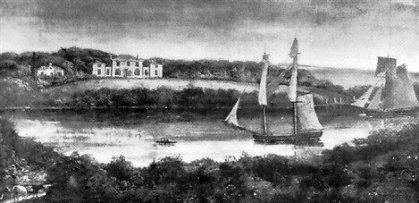
“…some day Barrow will become a Liverpool. Let it become a Liverpool if it will
and can, the old Liverpool will be none the worse, but better for it.”
The rest, as they say, is history.
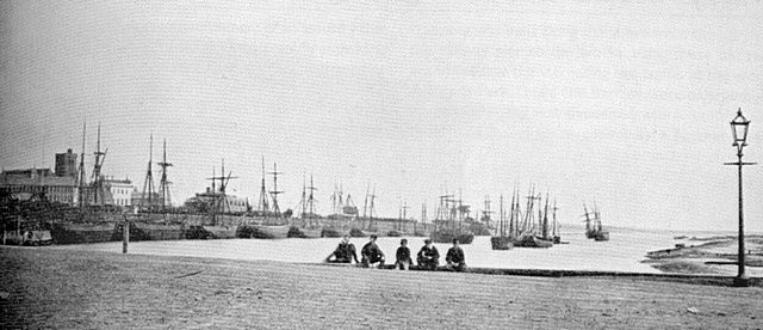
Devonshire Dock embankment, what would become Michaelson Road. c. 1867. In 1870 another
enbankment was built at Salthouse, (in the distance in this photo), to enable work to start on Buccleuch
Dock. The High Level Bridge was completed in 1882 over the pictured embankment.
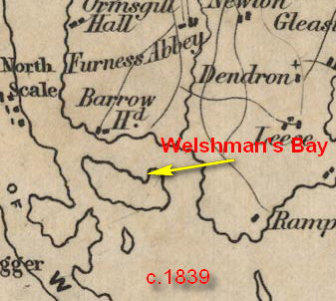

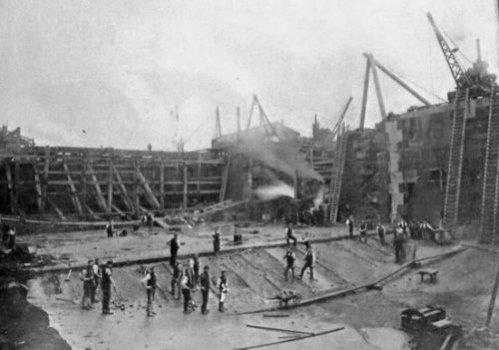




A Brief History
Barrow Channel before Buccleuch Dock was built,
showing Michaelson Mansion. Painting by Jane Michaelson



